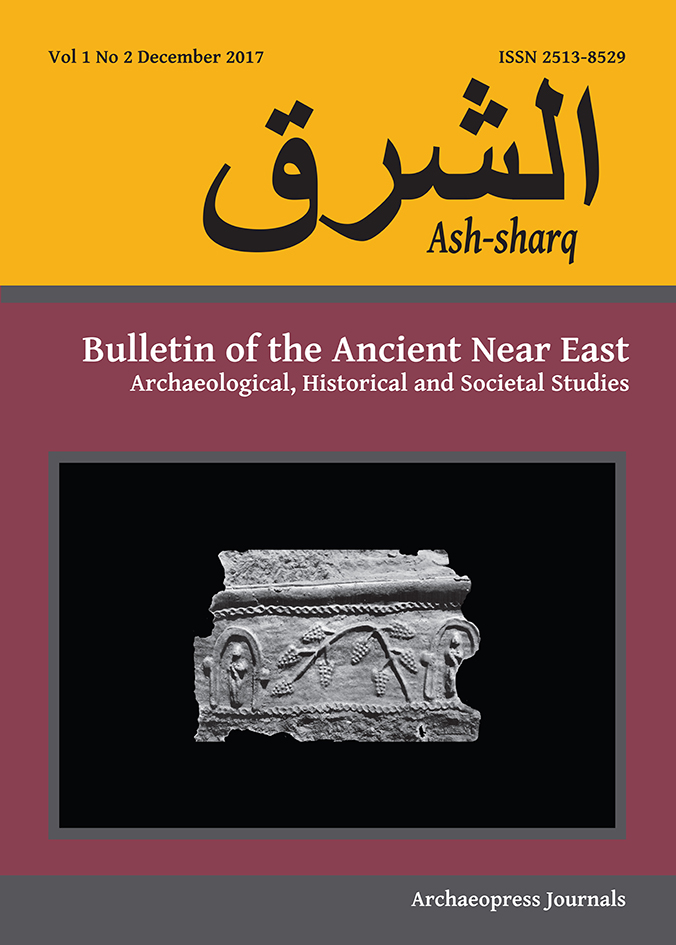The Agora, a Mark of Hellenisation? An Archaeological Note on Public Squares in Hellenised Mesopotamia and Parapotamia
Keywords:
Greek-style agorai, public squares, Hellenised Mesopotamia and ParapotamiaAbstract
This paper proposes a preliminary survey of Greek-style agorai, i.e. public squares hosting political and economic activities, within the settlements of the Euphrates’ and Tigris’ valleys under Seleucid and Parthian rule (Figure 1). Although most of the sites considered were either urban settlements or new foundations from the late 4th century BCE, the evidence we will be dealing with dates mainly from the 2nd century BCE onwards, after the reinforcement of the Greek poleis under Antiochos IV, and continues after the Parthian conquest of the region between the 140s and 110s. From that period, we can detect in several sites a reinforced emphasis on the proclaimed Hellenic heritage of the ruling class, both in the epigraphy — with the mention of Greek-style institutions such as the boulê and the appearance of dynastic cults — and in the archaeological record.
References
Alcock, S. 1994. Breaking up the Hellenistic World: Survey and Society. In I. Morris (ed), Classical Greece: Ancient Histories and Modern Archaeologies: 171-190. Cambridge : Cambridge University Press.
Andrae, W. and Lenzen, H. J. 1933. Die Partherstadt Assur (Ausgrabungen der Deutschen Orient-Gesellschaft in Assur 8). Osnabrück : Zeller.
Andrae, W. 1977. Das wiedererstandene Assur. München : C. H. Beck.
Coqueugniot, G. 2015. The Hellenistic Public Square in Europos in Parapotamia (Dura-Europos, Syria) and Seleucia on the Tigris (Iraq) during Parthian and Roman Times. In S. Chandrasekaran and A. Kouremenos (eds), Continuity and Destruction in the Greek East: 71-81. Oxford : Archaeopress.
Coqueugniot, G. 2016. Ancient Near-Eastern Traditions and Greco-Roman Culture in the agora of Europos-Doura (Syria). In R. A. Stucky, O. Kaelin and H. P. Mathys (eds), Proceedings of the 9th International Congress on the Archaeology of the Ancient Near East. 9-13 June 2014, Basel, vol. 2: 119-132. Wiesbaden: Harrassowitz Verlag.
Damerji, M. S. B. 2012. Babylon – KA.DINGIR.RA – ‘Gate of God’. The Story of a City killed by Legends and Oblivion. Mesopotamia XLVII: 1-101.
Gullini, G. 1967. Un contributo alla storia dell’urbanistica: Seleucia sul Tigri. Mesopotamia II: 135-163.
Hauser, S. R. 2011. Assur und sein Umland in der Arsakidenzeit. In J. Renger (ed), Assur – Gott, Stadt und Land, Colloquien der Deutschen Orient-Gesellschaft 5: 115-148. Saarbrücken: Harrassowitz Verlag.
Invernizzi, A. 1994. Hellenism in Mesopotamia. A View from Seleucia on the Tigris. Al-Rafidan 15: 1-25.
Kose, A. 1998. Uruk Architektur IV. Von der Seleukiden- bis zur Sasanidenzeit, Ausgrabungen in Uruk-Warka Endberichte 17. Mainz: Zabern.
Leriche, P. 2010. Europos-Doura séleucide. Electrum 18: 23-40.
Mallwitz, A., Wetzel, F. and Schmidt, E. 1957. Das Babylon der Spätzeit, Ausgrabungen der Deutschen Orient-Gesellschaft in Babylon 8. Berlin: Mann.
Margueron, J.-C. 2004. Mari. Métropole de l’Euphrate au IIIe et au début du IIe millénaire av. J.-C. Paris: Picard-ERC.
Margueron, J.-C. 2013. Cités invisibles: la naissance de l’urbanisme au Proche-Orient ancien. Approche archéologique. Paris: Geuthner.
Messina, V. 2010. Seleucia al Tigri. Il monumento di Tell ’Umar. Lo scavo e le fasi architettoniche, Monografie di Mesopotamia, XIII, Missione in Iraq, IV). Firenze: Le Lettere.
Messina, V. 2011. Seleucia on the Tigris. The Babylonian Polis of Antiochus I. Mesopotamia 46: 157-167.
Oates, J. 2008. The Changing Role of Nimrud. In J. E. Curtis, H. McCall, D. Collon and L. al-Gailani Werr (eds), New Light on Nimrud. Proceedings of the Nimrud Conference, 11th-13th March 2002: 273-277. London: British Institute for the Study of Iraq.
Reade, J. E. 1998. Greco-Parthian Nineveh. Iraq 60: 60-83.
van der Spek, R. J. 2001. The Theatre of Babylon in Cuneiform. In W. H. van Soldt (ed), Veenhof Anniversary Volume: Studies presented to Klaas R. Veenhof on the Occasion of his Sixty-Fifth Birthday: 445-456. Leiden : NINO.
Will, E. 1988. La population de Doura-Europos: une évaluation. Syria 65/3: 315-321.


